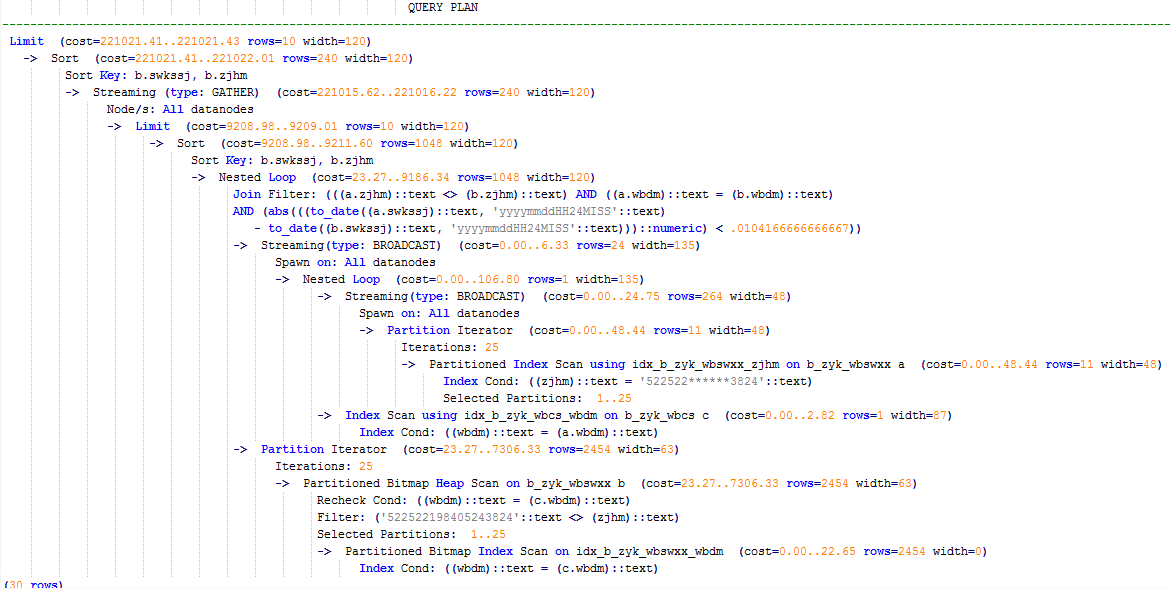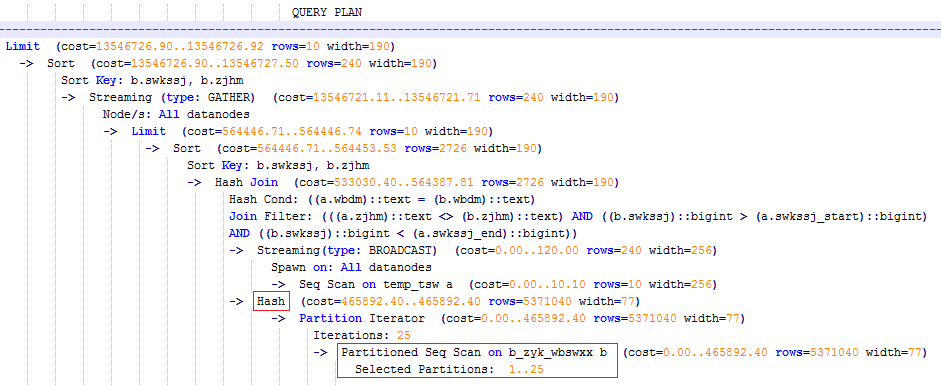Optimizing Statistics
What Is Statistic Optimization
GaussDB(DWS) generates optimal execution plans based on the cost estimation. Optimizers need to estimate the number of data rows and the cost based on statistics collected using ANALYZE. Therefore, the statistics is vital for the estimation of the number of rows and cost. Global statistics are collected using ANALYZE: relpages and reltuples in the pg_class table; stadistinct, stanullfrac, stanumbersN, stavaluesN, and histogram_bounds in the pg_statistic table.
Example 1: Poor Query Performance Due to the Lack of Statistics
The query performance is often significantly impacted by the absence of statistics for tables or columns involved in the query.
The structure of the example table is as follows:
1 2 3 4 5 6 7 8 9 10 11 12 13 14 15 16 17 18 19 20 21 22 23 24 25 26 27 28 29 30 31 32 |
CREATE TABLE LINEITEM ( L_ORDERKEY BIGINT NOT NULL , L_PARTKEY BIGINT NOT NULL , L_SUPPKEY BIGINT NOT NULL , L_LINENUMBER BIGINT NOT NULL , L_QUANTITY DECIMAL(15,2) NOT NULL , L_EXTENDEDPRICE DECIMAL(15,2) NOT NULL , L_DISCOUNT DECIMAL(15,2) NOT NULL , L_TAX DECIMAL(15,2) NOT NULL , L_RETURNFLAG CHAR(1) NOT NULL , L_LINESTATUS CHAR(1) NOT NULL , L_SHIPDATE DATE NOT NULL , L_COMMITDATE DATE NOT NULL , L_RECEIPTDATE DATE NOT NULL , L_SHIPINSTRUCT CHAR(25) NOT NULL , L_SHIPMODE CHAR(10) NOT NULL , L_COMMENT VARCHAR(44) NOT NULL ) with (orientation = column, COMPRESSION = MIDDLE) distribute by hash(L_ORDERKEY); CREATE TABLE ORDERS ( O_ORDERKEY BIGINT NOT NULL , O_CUSTKEY BIGINT NOT NULL , O_ORDERSTATUS CHAR(1) NOT NULL , O_TOTALPRICE DECIMAL(15,2) NOT NULL , O_ORDERDATE DATE NOT NULL , O_ORDERPRIORITY CHAR(15) NOT NULL , O_CLERK CHAR(15) NOT NULL , O_SHIPPRIORITY BIGINT NOT NULL , O_COMMENT VARCHAR(79) NOT NULL )with (orientation = column, COMPRESSION = MIDDLE) distribute by hash(O_ORDERKEY); |
The query statements are as follows:
1 2 3 4 5 6 7 8 9 10 11 12 13 14 15 16 17 18 19 20 21 |
explain verbose select count(*) as numwait from lineitem l1, orders where o_orderkey = l1.l_orderkey and o_orderstatus = 'F' and l1.l_receiptdate > l1.l_commitdate and not exists ( select * from lineitem l3 where l3.l_orderkey = l1.l_orderkey and l3.l_suppkey <> l1.l_suppkey and l3.l_receiptdate > l3.l_commitdate ) order by numwait desc; |
You can perform the following operations to check whether ANALYZE has been executed on the tables or columns involved in the query to collect statistics.
- Execute EXPLAIN VERBOSE to analyze the execution plan and check the warning information.
WARNING:Statistics in some tables or columns(public.lineitem(l_receiptdate,l_commitdate,l_orderkey, l_suppkey), public.orders(o_orderstatus,o_orderkey)) are not collected. HINT:Do analyze for them in order to generate optimized plan.
- To determine if poor query performance was caused by a lack of statistics in certain tables or columns, check if the following information exists in the log file located in the pg_log directory.
2017-06-14 17:28:30.336 CST 140644024579856 20971684 [BACKEND] LOG:Statistics in some tables or columns(public.lineitem(l_receiptdate, l_commitdate,l_orderkey, .l_suppkey), public.orders(o_orderstatus,o_orderkey)) are not collected. 2017-06-14 17:28:30.336 CST 140644024579856 20971684 [BACKEND] HINT:Do analyze for them in order to generate optimized plan.
After confirming that ANALYZE has not been executed on the relevant tables or columns, you can execute ANALYZE on the tables or columns reported in the WARNING or logs to resolve the issue of slow query performance due to a lack of statistics
Example 2: Setting cost_param to Optimize Query Performance
For details, see Case: Configuring cost_param for Better Query Performance.
Example 3: Optimization is Not Accurate When Intermediate Results Exist in the Query Where JOIN Is Used for Multiple Tables
Symptom: Query the personnel who have checked in an Internet cafe within 15 minutes before and after the check-in of a specified person.
1 2 3 4 5 6 7 8 9 10 11 12 13 14 15 16 17 18 19 20 21 |
SELECT C.WBM, C.DZQH, C.DZ, B.ZJHM, B.SWKSSJ, B.XWSJ FROM b_zyk_wbswxx A, b_zyk_wbswxx B, b_zyk_wbcs C WHERE A.ZJHM = '522522******3824' AND A.WBDM = B.WBDM AND A.WBDM = C.WBDM AND abs(to_date(A.SWKSSJ,'yyyymmddHH24MISS') - to_date(B.SWKSSJ,'yyyymmddHH24MISS')) < INTERVAL '15 MINUTES' ORDER BY B.SWKSSJ, B.ZJHM limit 10 offset 0 ; |
Figure 1 shows the execution plan. This query takes about 12s.
Optimization analysis:
- In the execution plan, index scan is used for node scanning, the Join Filter calculation in the external NEST LOOP IN statement consumes most of the query time, and the calculation uses the string addition and subtraction, and unequal-value comparison.
- Use an unlogged table to record the Internet access time of the specified person. The start time and end time are processed during data insertion, and this reduces subsequent addition and subtraction operations.
1 2 3 4 5 6 7 8 9 10 11 12 13 14 15 16 17 18 19 20 21 22 23 24 25 26 27 28 29 30 31 32 33 34 35 36 37 38 39 40 41 42 43 44 45 46 47 48 49 50 51 52
//Create a temporary unlogged table. CREATE UNLOGGED TABLE temp_tsw ( ZJHM NVARCHAR2(18), WBDM NVARCHAR2(14), SWKSSJ_START NVARCHAR2(14), SWKSSJ_END NVARCHAR2(14), WBM NVARCHAR2(70), DZQH NVARCHAR2(6), DZ NVARCHAR2(70), IPDZ NVARCHAR2(39) ) ; //Insert the Internet access record of the specified person, and process the start time and end time. INSERT INTO temp_tsw SELECT A.ZJHM, A.WBDM, to_char((to_date(A.SWKSSJ,'yyyymmddHH24MISS') - INTERVAL '15 MINUTES'),'yyyymmddHH24MISS'), to_char((to_date(A.SWKSSJ,'yyyymmddHH24MISS') + INTERVAL '15 MINUTES'),'yyyymmddHH24MISS'), B.WBM,B.DZQH,B.DZ,B.IPDZ FROM b_zyk_wbswxx A, b_zyk_wbcs B WHERE A.ZJHM='522522******3824' AND A.WBDM = B.WBDM ; //Query the personnel who have check in an Internet cafe before and after 15 minutes of the check-in of the specified person. Convert their ID card number format to int8 in comparison. SELECT A.WBM, A.DZQH, A.DZ, A.IPDZ, B.ZJHM, B.XM, to_date(B.SWKSSJ,'yyyymmddHH24MISS') as SWKSSJ, to_date(B.XWSJ,'yyyymmddHH24MISS') as XWSJ, B.SWZDH FROM temp_tsw A, b_zyk_wbswxx B WHERE A.ZJHM <> B.ZJHM AND A.WBDM = B.WBDM AND (B.SWKSSJ)::int8 > (A.swkssj_start)::int8 AND (B.SWKSSJ)::int8 < (A.swkssj_end)::int8 order by B.SWKSSJ, B.ZJHM limit 10 offset 0 ;
The query takes about 7s. Figure 2 shows the execution plan.
- In the previous plan, Hash Join has been executed, and a Hash table has been created for the large table b_zyk_wbswxx. The table contains large amounts of data, so the creation takes long time.
temp_tsw contains only hundreds of records, and an equal-value connection is created between temp_tsw and b_zyk_wbswxx using wbdm (the Internet cafe code). Therefore, if JOIN is changed to NEST LOOP JOIN, index scan can be used for node scanning, and the performance will be boosted.
- Execute the following statement to change JOIN to NEST LOOP JOIN.
1SET enable_hashjoin = off;
Figure 3 shows the execution plan. The query takes about 3s.
- Save the query result set in the unlogged table for paging display.
If paging display needs to be achieved on the upper-layer application page, change the offset value to determine the result set on the target page. In this way, the previous query statement will be executed every time after a page turning operation, which causes long response latency.
To resolve this problem, you are advised to use the unlogged table to save the result set.
1 2 3 4 5 6 7 8 9 10 11 12 13 14 15 16 17 18 19 20 21 22 23 24 25 26 27 28 29 30 31 32 33 34 35 36 37 38 39 40 41 42 43 44 45
//Create an unlogged table to save the result set. CREATE UNLOGGED TABLE temp_result ( WBM NVARCHAR2(70), DZQH NVARCHAR2(6), DZ NVARCHAR2(70), IPDZ NVARCHAR2(39), ZJHM NVARCHAR2(18), XM NVARCHAR2(30), SWKSSJ date, XWSJ date, SWZDH NVARCHAR2(32) ); //Insert the result set to the unlogged table. The insertion takes about 3s. INSERT INTO temp_result SELECT A.WBM, A.DZQH, A.DZ, A.IPDZ, B.ZJHM, B.XM, to_date(B.SWKSSJ,'yyyymmddHH24MISS') as SWKSSJ, to_date(B.XWSJ,'yyyymmddHH24MISS') as XWSJ, B.SWZDH FROM temp_tsw A, b_zyk_wbswxx B WHERE A.ZJHM <> B.ZJHM AND A.WBDM = B.WBDM AND (B.SWKSSJ)::int8 > (A.swkssj_start)::int8 AND (B.SWKSSJ)::int8 < (A.swkssj_end)::int8 ; //Perform paging query on the result set. The paging query takes about 10 ms. SELECT * FROM temp_result ORDER BY SWKSSJ, ZJHM LIMIT 10 OFFSET 0;

Collecting global statistics using ANALYZE improves query performance.
If a performance problem occurs, you can use plan hint to adjust the query plan to the previous one. For details, see Hint-based Tuning.
Feedback
Was this page helpful?
Provide feedbackThank you very much for your feedback. We will continue working to improve the documentation.See the reply and handling status in My Cloud VOC.
For any further questions, feel free to contact us through the chatbot.
Chatbot








